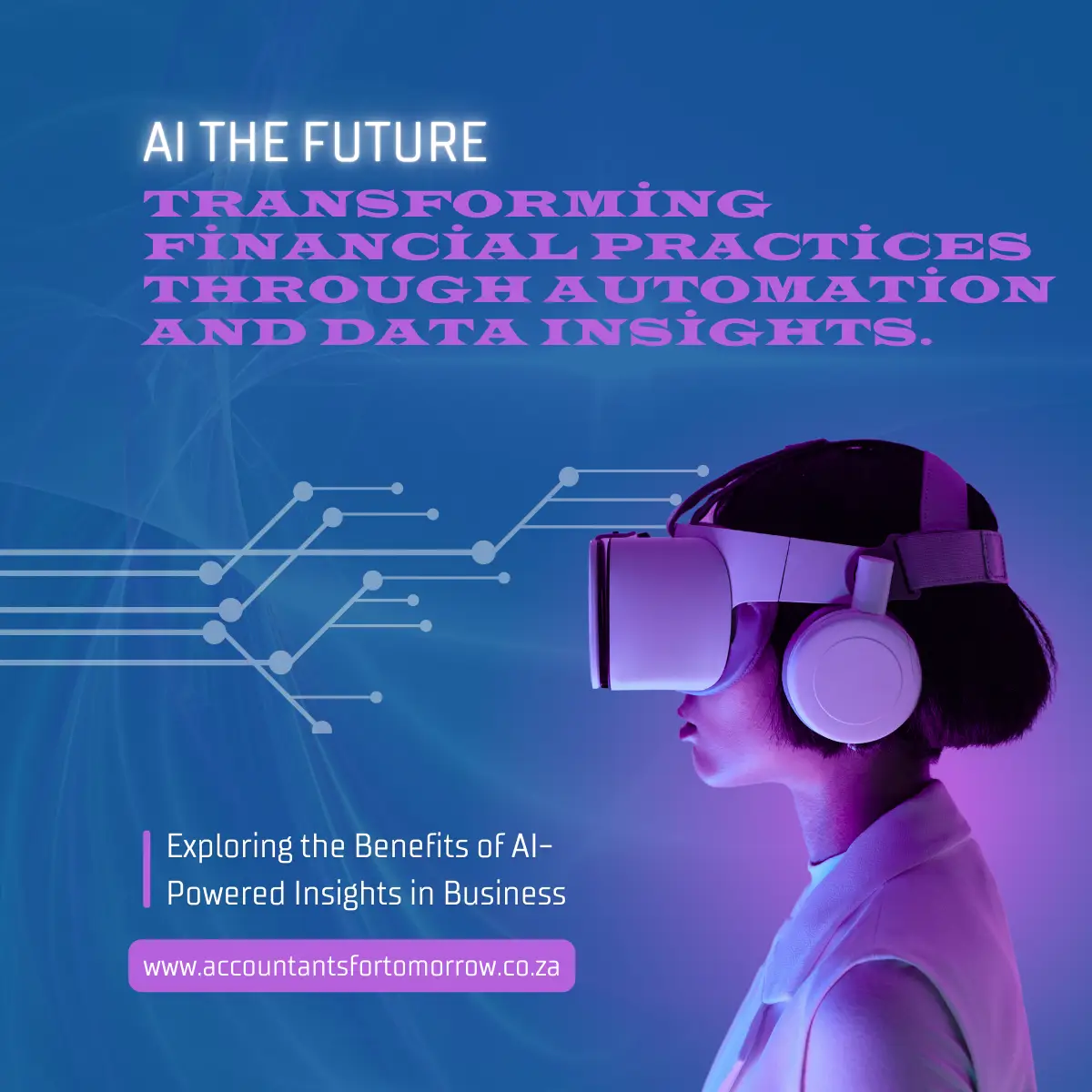
In today’s fast-paced corporate world, technology isn’t just an advantage; it’s a necessity—especially in the accounting industry. The influence of artificial intelligence (AI) in the finance sector is profound and transformative. Automating manual processes is just one aspect of the improvements AI brings to risk management, client experience, algorithmic trading, and fraud detection. AI has revolutionized the operations of financial organizations by assisting accounting firms in streamlining procedures, increasing accuracy, and providing greater value to their clients.
Despite the overwhelming amount of data that financial institutions deal with, extracting insightful information remains challenging. Conventional techniques require specific knowledge and are often labor-intensive and complex, leading to missed opportunities, inefficiency, and poor customer experience. By integrating AI into CIMA, you can strengthen your financial team’s capacity to convert data into useful insights, optimize processes, and provide outstanding customer service.
Automation of tasks
Automation involves using technology to streamline routine, repetitive, and often manual tasks. This typically includes automating procedures like scheduling, data entry, and creating workbooks without human input through a work management platform. The CGMA syllabus covers essential topics such as risk management, financial planning, and management accounting—skills that are increasingly important in the era of automation and AI.
Advantages of Task Automation
Automating routine chores cuts down on low-value labour and frees up your team to concentrate on high-impact projects, which, among other advantages, results in cost savings like:
- heightened effectiveness: Processes are completed faster with fewer errors.
- increased output: Teams can handle more work as automation takes over repetitive tasks.
- decreased mistakes: Reduced human intervention minimizes errors.
- reduced waiting time: Tasks are completed quicker, improving overall workflow.
- increased worker satisfaction: Employees are freed from mundane tasks, allowing them to engage in more meaningful work.
To gauge how successful your automation efforts are, you can monitor several important metrics, such as:
- Error reduction: Compare the frequency of errors before and after implementing automation, using employee self-reporting or manual error logs.
- Savings: Evaluate how much operating costs are reduced through automation, considering both direct and indirect savings such as time saved and increased productivity.
- Shorter meetings with shorter durations: Assess whether there has been a noticeable reduction in the number or duration of meetings since process automation, using surveys and calendar data.
Remember, this data is not just for assessment but also for ongoing improvement. Your automation strategies should be adjusted and refined based on these metrics and feedback. The CGMA Program also offers training on the latest technical trends and tools, ensuring that professionals are equipped to handle the technologies driving change. Ultimately, automation should free up your staff to focus on strategically important work that drives business results.
Improved Analysis of Data
Data is the new oil, and in the current digital age, it is a valuable resource continuously exploited. The complexity of data increases daily, making it more challenging to extract valuable insights. AI-led data analysis addresses this by transforming massive volumes of data into actionable knowledge. If data is the oil, AI is the refinery that processes it.
Data analytics has been completely transformed by artificial intelligence, which has resulted in a dramatic change in how we handle and understand massive datasets. The days of manually examining databases and spreadsheets are long gone.
AI enables businesses to make data-driven, well-informed decisions more quickly, accurately, and automatically than ever before. AI-driven analytics-capable organizations are well-positioned to lead in this new era of innovation and strategic foresight.
Data analysis involves examining, cleaning, modifying, and structuring data to extract relevant information, draw inferences, and support decision-making. The CGMA places a strong emphasis on cultivating strategic competencies like leadership, business acumen, and decision-making. The need for these abilities is growing as positions take on more strategic duties.
To extract useful insights from unprocessed data, a variety of techniques are used, including statistical methods, machine learning, and visualization. However, what happens if artificial intelligence is included?
For instance, AI technology from JP Morgan can review approximately 12,000 documents in a fraction of the time it would take a human. A person would need 360,000 hours in seconds, on identical records (Yadav and Brummer, 2019).
Three words capture the significance of AI in data analytics:
Scalability, Precision, and Speed
The amount of data being collected is increasing exponentially, making traditional analysis techniques less accurate, efficient, and timely. AI-powered technologies are faster and more accurate than human analysts, processing and analyzing large amounts of data in a fraction of the time. Furthermore, AI is extremely scalable for expanding datasets, as it can continuously learn new skills and enhance its existing ones with minimal human intervention.
AI-powered solutions give organizations real-time insights by quickly analyzing and interpreting enormous volumes of data. AI can also improve productivity by quickly recovering commands and suggesting different approaches to data processing. This is very useful when browsing through several libraries for data analysis. The CGMA Program promotes a comprehensive comprehension of the business environment, empowering professionals to make valuable contributions towards the strategic objectives of their organization.
Six Advantages of AI in Data Analysis
AI data analysis has several advantages. Organizations can gain from using artificial intelligence in their data analysis process in the following ways:
1. Quicker understanding and increased effectiveness
AI-powered solutions can analyze and interpret enormous volumes of data quickly, giving organizations real-time insights. AI can also improve productivity by quickly recovering commands and suggesting different approaches to data processing. This is very useful when browsing through several libraries for data analysis.
2. Enhanced Accuracy
Enhanced accuracy is possible because AI is less biased and prone to human mistakes than humans are, which makes data analysis more accurate. If analytics results don’t match what was expected, AI can look into why. Even patterns, trends, and connections that might otherwise be missed might be found by it.
3.Democratized Information
The power of artificial intelligence (AI) and how chatbots use it for natural language processing (NLP) is democratizing data access. This development makes it possible for workers who are not data experts to evaluate large datasets and extract significant insights without having to become fluent in complicated data science jargon.
4. Savings on costs
Organizations can save time and money by automating data analysis processes that would have otherwise required manual labour. By producing reports automatically, AI simplifies the process and eliminates the need for human compilation after each analysis.
5.Improved scalability
As was previously noted, AI is extremely scalable for expanding datasets because it can constantly learn and enhance its skills.
6.Improved judgement
Organizations can confidently make data-driven decisions with faster and more accurate insights, which improves results.
As AI technology advances, its impact on data analysis will only increase. Integrating AI into your data analysis process can elevate your organization’s performance, regardless of its size.
Identification and prevention of fraud
Fraud is a significant challenge for financial institutions, but AI offers powerful tools for identifying and preventing fraudulent activities. AI in finance uses sophisticated algorithms and machine learning techniques to rapidly analyze vast amounts of data, identifying subtle patterns and unusual behaviors that may indicate fraud.
Types of Financial Transaction Fraud
Financial transaction fraud comes in many forms, including:
Identity theft: when someone steals personal data to assume another person’s identity for financial gain.
Credit Card Fraud: Unauthorized use of a credit card for purchases or withdrawals.
Phishing Scams: Deceptive tactics to trick victims into divulging sensitive information, such as bank account details or passwords.
Account Takeover: When a fraudster gains unauthorized access to someone’s bank accounts.
AI’s Role in Fraud Detection
AI-driven fraud detection systems use various forms of machine learning, including:
- Under supervised learning, the computer picks up knowledge from samples that have been tagged. It’s like teaching a computer by having it see instances of both legitimate and fraudulent transactions. Then, it may identify similar patterns in fresh transactions by applying what it has learnt.
- Unsupervised learning: In this type of learning, the computer does not require tagged data. It looks through the data on its own, looking for trends and oddities. Even if it hasn’t observed the strange actions before, it can still identify them as potentially fraudulent.
- Reinforcement learning: This method of instruction involves making mistakes and trying again. The AI tries many things and gains knowledge from the results. When fraud tendencies shift over time, this can be helpful. Reinforcement learning can be used to effectively identify and prevent fraudulent activities. Artificial intelligence (AI)-driven financial fraud detection offers several benefits for the finance industry.
The following are the benefits of using AI for fraud detection and prevention:
- Prevention and detection in real-time
AI in an organization’s algorithms can easily spot suspicious conduct as it happens by assessing transactions in real-time. This makes it possible for financial institutions to stop fraudulent transactions before they do harm by starting and providing AI fraud prevention.
- Enhanced precision and effectiveness
Artificial intelligence (AI) can process large amounts of data more rapidly and correctly than humans. As a result, there are fewer false positives and more accurate fraud detection, which eliminates the need for manual inspection and saves time and money.
- Decrease in false positives
Conventional techniques for detecting fraud frequently produce false alarms, labelling legal transactions as fraudulent. Artificial intelligence (AI) in finance promotes a more seamless user experience, minimizes false positives, and differentiates between legitimate and fraudulent transactions.
- Ability to adjust to changing risks
In the financial industry, AI and ML can continuously learn and adjust to new fraud patterns and strategies employed by scammers. Because of their adaptability, AI-powered systems can keep up with emerging risks and provide a robust defense against changing fraud schemes.
- The ability to scale
With artificial intelligence (AI), fraud detection systems may easily grow to accommodate higher transaction volumes without losing precision or effectiveness. Financial institutions may effectively manage fraud detection operations even during times of high transaction volume thanks to its scalability.
- Economy of scale
Long-term cost savings can be achieved by employing AI for fraud detection, despite possible upfront expenses. It accomplishes this by performing tasks that ordinarily need human labour automatically and by thwarting fraud before it results in significant losses. AI is therefore a wise decision for banks and other financial organizations.
Consequently, AI provides flexibility, scalability, and cost-effectiveness and has made fraud detection more secure and efficient. For AI development businesses, this makes it an essential tool for safeguarding financial transactions.
Future Applications of AI in Finance
AI is poised to drive the expansion of financial services. Many firms have embraced digital transformation, discovering new avenues for sales, efficiencies, and data-driven strategies. Financial institutions must enhance the personalization of relationship-based client engagement in the future. AI is crucial in facilitating customized customer service, generating safer and more responsible product and service recommendations, and building trust by expanding the range of concierge services that are offered at the most convenient times for clients.
To fully realize AI’s potential, financial institutions must also develop robust, permission-based digital client profiles. By breaking down data silos and implementing an AI layer, they can design experiences that scale effectively while catering to specific client demands.
Looking Ahead to an AI-Powered Future
AI in finance is evolving in response to these developments. Here are several ways aspiring and current financial professionals can enhance their knowledge of digital technology, AI, and data analytics:
Enroll in relevant courses: Consider taking classes in data analysis, automation, and artificial intelligence. Numerous accounting courses are available to assist you in staying up to date.
Stay updated: Keep informed about the latest advancements and trends through webinars and professional networks.
Connect with Peers: Get involved in professional associations and networks to exchange insights, firsthand accounts, and tactics for adjusting to technological advancements.
CONCLUSION
As AI and automation reshape the finance sector, finance professionals face both opportunities and challenges. These technologies enable finance teams to become more strategic and value-focused by automating repetitive tasks and improving data analysis, fraud detection, and prevention methods. Pursuing the CGMA designation is an excellent way to prepare for these changes, equipping you with the skills and knowledge necessary to thrive in this evolving landscape.





IT Telkom
How does AI improve the accuracy of data analysis, and in what ways does it identify patterns, trends, and connections that might otherwise be missed by humans?
Regard IT Telkom
AFT
AI enhances the accuracy of data analysis by processing vast amounts of information quickly and minimizing human errors. It uses advanced algorithms and machine learning models to detect subtle patterns, trends and correlations that might go unnoticed by humans due to cognitive limitations or biases.